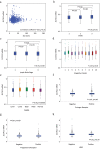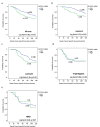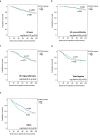The amino acid transporter SLC7A11 expression in breast cancer
- PMID: 38073087
- PMCID: PMC10761065
- DOI: 10.1080/15384047.2023.2291855
The amino acid transporter SLC7A11 expression in breast cancer
Abstract
Breast cancer (BC), characterized by its diverse molecular profiles and clinical outcomes, presents a significant challenge in the development of effective therapeutic strategies. Metabolic reprogramming, a defining characteristic of cancer, has emerged as a promising target for novel therapies. SLC7A11, an amino acid transporter that facilitates cysteine uptake in exchange for glutamate, plays a crucial role in sustaining the altered metabolism of cancer cells. This study delves into the comprehensive analysis of SLC7A11 at the genomic, transcriptomic, and protein levels in extensive BC datasets to elucidate its potential role in different BC subtypes. SLC7A11 gene copy number and mRNA expression were evaluated using the Molecular Taxonomy of Breast Cancer International Consortium (METABRIC) cohort (n = 1,980) and Breast Cancer Gene Expression Miner (n = 4,712). SLC7A11 protein was assessed using immunohistochemistry in a large BC cohort (n = 1,981). Additionally, The Cancer Genome Atlas (TCGA) dataset was used to explore SLC7A11 DNA methylation patterns using MethSurv (n = 782) and association of SLC7A11 mRNA expression with immune infiltrates using TIMER (n = 1,100). High SLC7A11 mRNA and SLC7A11 protein expression were significantly associated with high tumor grade (p ≤ .02), indicating a potential role in cancer progression. Interestingly, SLC7A11 copy number gain was observed in HER2+ tumors (p = .01), suggesting a subtype-specific association. In contrast, SLC7A11 mRNA expression was higher in the basal-like/triple-negative (TN; p < .001) and luminal B tumors (p = .02), highlighting its differential expression across BC subtypes. Notably, high SLC7A11 protein expression was predominantly observed in Estrogen Receptor (ER)-negative and Triple Negative (TN) BC, suggesting a role in these aggressive subtypes. Further analysis revealed that SLC7A11 was positively correlated with other amino acid transporters and enzymes associated with glutamine metabolism, implying a coordinated role in metabolic regulation. Additionally, SLC7A11 gene expression was positively associated with neutrophil and macrophage infiltration, suggesting a potential link between SLC7A11 and tumor immunity. Our findings suggest that SLC7A11 plays a significant role in BC metabolism, demonstrating differential expression across subtypes and associations with poor patient outcomes. Further functional studies are warranted to elucidate the precise mechanisms by which SLC7A11 contributes to BC progression and to explore its potential as a therapeutic target.
Keywords: Breast cancer; IHC; SLC7A11 expression; amino acid transporters; metabolism; prognostic factor; subtypes.
Conflict of interest statement
No potential conflict of interest was reported by the authors.
Figures




References
MeSH terms
Substances
LinkOut - more resources
Full Text Sources
Medical
Research Materials
Miscellaneous
